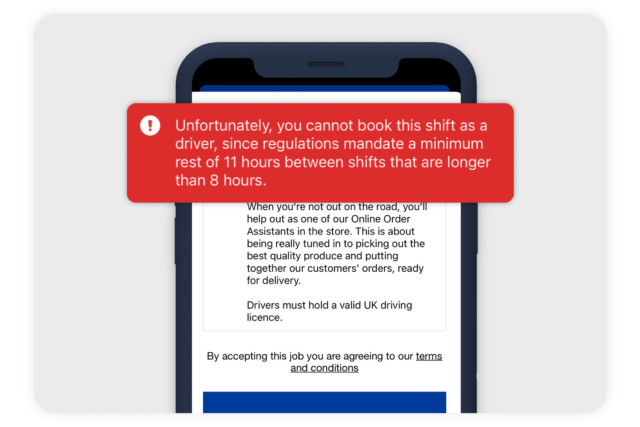
Although you may want to work as many hours/shifts as possible, and as much as certain employers may want you back time and again, we have to put a limit on this. This is because of a legal requirement for us to follow something called the UK Working Time Directive (WTD). But it’s not just to be legally compliant that we follow this; it’s also for both your physical health and your mental wellbeing. In short, we don’t want you to burn out. Ultimately, all employers, whether Indeed Flex or another organisation, have a ‘Duty of Care’ to you as an employee. This ensures that you’re not overworked and maintain a healthy work/life balance, while still earning a decent wage. This is why, although it may seem frustrating, we’ve added a notification to the app which lets you know if you’re going against WTD rules in trying to book a shift i.e it’s too close to the one you’ve just worked.

The basics, in relation to all roles, are:
- You cannot work more than 60 hours a week (rolling basis).
- No single shift should be over 15 hours long.
- If you book a shift of 15 hours, you cannot book another one 11 hours before or after that shift.
- For driving roles, you cannot work more than 13 hours (over a single or multiple-shift) in a 24 hour period.
To delve a little deeper into the Working Time Directive, read on to gain a greater understanding of what it is and how it ensures you’re treated fairly and reasonably.
1. What is the UK Working Time Directive?
The UK Working Time Directive originally came from the European Union’s Working Time Directive. It sets out minimum requirements for working time, rest breaks, and annual leave for all workers in the UK, whether temporary or permanent. Its sole aim is to prevent exploitation and promote a healthy work-life balance.
2. Maximum Working Hours:
Temporary workers are protected by a maximum working week of 48 hours, including both regular working hours and overtime. However, Flexers are given the option to voluntarily opt-out of this limit, up to a maximum of 60 hours per week.
3. Rest Breaks:
Under the WTD, you’re entitled to a minimum rest period of 20 minutes if your shift exceeds 6 hours. You’re also entitled to a rest period of at least 11 consecutive hours between each working day. This is to help you: it’s there to prevent fatigue and allow you time to recover.
4. Annual Leave:
All temporary workers are entitled to annual leave, so you can have regular breaks from work, just like any other employee would expect to. The WTD states that workers should receive at least 5.6 weeks (28 days) of paid leave per year.
5. Record-Keeping and Access To Information:
The WTD states that, as your employer, we need to keep records of your working hours. As a Flexer, you have the right to access these records at any time to verify your working hours and ensure we’re complying with WTD rules.
6. Legal Protection:
Temporary workers are protected against unfair treatment or dismissal for exercising their rights under the WTD. If we, or any employer, fail to comply with the relevant rules and regulations, you have the right to make a complaint to an employment tribunal, seeking compensation where appropriate.
Overall, the UK WTD is there to safeguard you, the Flexer – ensuring that you’re treated fairly, work reasonable hours, get rest breaks, and can take annual leave. In turn, this creates a healthy work-life balance and helps to prevent you from being exploited. We know that many of you would happily work all the hours available, but we have to comply with UK law and, ultimately, don’t want you to be overworked, as your welfare is of paramount importance to us.








